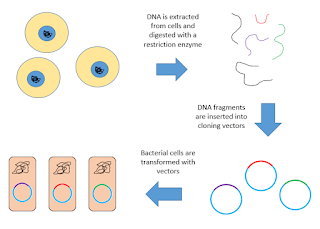Write Short Note on cDNA library
A cDNA library is a collection of complementary DNA (cDNA) clones synthesised from total mRNA of an organism.
- c-DNA or complenmentary DNA is a double stranded complement of m-RNA.
- c-DNA is synthesized from m-RNA by the process of reverse transcription.
- As the process is discovered by Temin and Baltimore it is also called as Teminism.
- Genomic DNA of eukaryotes contain coding and noncoding sequences.
- Genomic library represents the entire genome of an organism hence it may not use for eukaryotes.
- c-DNA represents only those genes that are being expressed by a perticular cell.
- Since m-RNA lacks noncoding reion this
- library would represent only the coding sequences of the genes.
- At first the m-RNA of interest is isolated from the cell.
- This m-RNA is reverse transcribed into c-DNA molecule by using reverse transcriptase enzymes.
- These single stranded c-DNA molecules converted into double stranded molecules.
- The double stranded DNA molecule is them inserted into vector and from recombinant DNA molecule which further introduced into a suitable vector.
- Production of human proteins like interferons, insulin blood clotting factor VIII can be done with CDNA.

